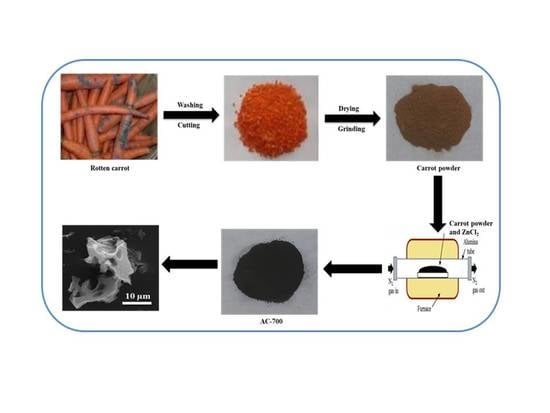Biomass-Derived Activated Carbon as a Catalyst for the Effective Degradation of Rhodamine B dye
Abstract
:1. Introduction
2. Materials and Methods
2.1. Materials
2.2. Fabrication of AC
2.3. Characterization
2.4. Catalytic Degradation and Kinetics Study
3. Results and Discussion
3.1. Physico-Chemical Characterization of AC
3.2. Evaluation of Catalytic Activity of AC
3.2.1. Variation of Catalyst’s Type
3.2.2. Effect of pH
3.2.3. Initial Dye Concentration
3.2.4. Effect of Catalyst Dosage
3.2.5. Effect of Temperature
4. Recyclability Study
5. Conclusions
Supplementary Materials
Author Contributions
Funding
Acknowledgments
Conflicts of Interest
References
- Khatri, A.; Peerzada, M.H.; Mohsin, M.; White, M. A review on developments in dyeing cotton fabrics with reactive dyes for reducing effluent pollution. J. Clean. Prod. 2015, 87, 50–57. [Google Scholar] [CrossRef]
- Richardson, S.D.; Kimura, S.Y. Water Analysis: Emerging Contaminants and Current Issues. Anal. Chem. 2016, 88, 546–582. [Google Scholar] [CrossRef] [PubMed]
- Kim, K.; Ihm, S. Heterogeneous catalytic wet air oxidation of refractory organic pollutants in industrial wastewaters: A review. J. Hazard. Mater. 2011, 186, 16–34. [Google Scholar] [CrossRef] [PubMed]
- Mittal, A.; Malviya, A.; Kaur, D.; Mittal, J.; Kurup, L. Studies on the adsorption kinetics and isotherms for the removal and recovery of Methyl Orange from wastewaters using waste materials. J. Hazard. Mater. 2007, 148, 229–240. [Google Scholar] [CrossRef]
- Richardson, S.D.; Willson, C.S.; Rusch, K.A. Use of Rhodamine Water Tracer in the Marshland Upwelling System. Ground Water 2004, 42, 678–688. [Google Scholar] [CrossRef] [PubMed]
- Merouani, S.; Hamdaoui, O.; Saoudi, F.; Chiha, M. Sonochemical degradation of Rhodamine B in aqueous phase: Effects of additives. Chem. Eng. J. 2010, 158, 550–557. [Google Scholar] [CrossRef]
- Yuan, Q.; Liu, Y.; Li, L.; Li, Z.; Fang, C.; Duan, W.; Li, X.; Yan, C. Highly ordered mesoporous titania–zirconia photocatalyst for applications in degradation of rhodamine-B and hydrogen evolution. Microporous Mesoporous Mater. 2009, 124, 169–178. [Google Scholar] [CrossRef]
- Li, Y.; Sun, S.; Ma, M.; Ouyang, Y.; Yan, Y. Kinetic study and model of the photocatalytic degradation of rhodamine B (RhB) by a TiO2-coated activated carbon catalyst: Effects of initial RhB content, light intensity and TiO2 content in the catalyst. Chem. Eng. J. 2008, 142, 147–155. [Google Scholar] [CrossRef]
- He, Z.; Sun, C.; Yang, S.; Ding, Y.; He, H.; Wang, Z. Photocatalytic degradation of rhodamine B by Bi2WO6 with electron accepting agent under microwave irradiation: Mechanism and pathway. J. Hazard. Mater. 2009, 162, 1477–1486. [Google Scholar] [CrossRef]
- Merouani, S.; Hamdaoui, O.; Saoudi, F.; Chiha, M.; Pétrier, C. Influence of bicarbonate and carbonate ions on sonochemical degradation of Rhodamine B in aqueous phase. J. Hazard. Mater. 2010, 175, 593–599. [Google Scholar] [CrossRef]
- Mehrdad, M.; Hashemzadeh, M. Ultrasonic degradation of Rhodamine B in the presence of hydrogen peroxide and some metal oxide. Ultrason. Sonochem. 2010, 17, 168–172. [Google Scholar] [CrossRef] [PubMed]
- Ju, D.J.; Byun, I.G.; Park, J.J.; Lee, C.H.; Ahn, G.H.; Park, T.J. Biosorption of a reactive dye (Rhodamine-B) from an aqueous solution using dried biomass of activated sludge. Bioresource Technol. 2008, 99, 7971–7975. [Google Scholar] [CrossRef] [PubMed]
- Nigra, M.M.; Ha, J.; Katz, A. Identification of site requirements for 4-nitrophenol using gold nanoparticles catalyst. Catal. Sci. Technol. 2013, 3, 2976–2983. [Google Scholar] [CrossRef]
- Junejo, Y.; Baykal, A. Ultrarapid catalytic reduction of some dyes by reusable novel erythromycin-derived silver nanoparticles. Turk. J. Chem. 2014, 38, 765–774. [Google Scholar] [CrossRef]
- Parab, H.; Sudersanan, M.; Shenoy, N.; Pathare, T.; Vaze, B. Use of Agro-Industrial Wastes for Removal of Basic Dyes from Aqueous Solutions. Clean Soil Air Water 2009, 37, 963–969. [Google Scholar] [CrossRef]
- Lacerda, V.S.; Sotelo, J.B.; Guimaraes, A.; Navarro, S.; Bascones, M.; Gracia, L.M.; Ramos, P.; Gil, J. Rhodamine B removal with activated carbons obtained from lignocellulose waste. J. Environ. Manag. 2015, 155, 67–76. [Google Scholar] [CrossRef] [Green Version]
- Bello, O.S.; Adegoke, K.A.; Fagbenro, S.O.; Lameed, O.S. Functionalized coconut husks for rhodamine-B dye sequestration. Appl. Water Sci. 2019, 9, 189. [Google Scholar] [CrossRef] [Green Version]
- Guo, Y.; Zhao, J.; Zhang, H.; Yang, S.; Qi, J.; Wang, Z.; Xu, H. Use of rice husk-based porous carbon for adsorption of Rhodamine B from aqueous solutions. Dyes Pigments 2005, 66, 123–128. [Google Scholar] [CrossRef]
- Panda, G.C.; Das, S.K.; Guha, A.K. Jute stick powder as a potential biomass for the removal of congo red and Rhodamine B from their aqueous solution. J. Hazard. Mater. 2009, 164, 374–379. [Google Scholar] [CrossRef]
- Kumar, T.K.M.P.; Kumar, S.K.A. Visible-light-induced degradation of rhodamine B by nanosized Ag2S–ZnS loaded on cellulose. Photochem. Photobiol. Sci. 2019, 18, 148–154. [Google Scholar] [CrossRef]
- Xiao, X.; Ma, X.; Liu, Z.; Li, W.; Yuan, H.; Ma, X.; Li, L. Degradation of rhodamine B in a novel bio-photoelectric reductive system composed of Shewanella oneidensis MR-1 and Ag3PO4. Environ. Int. 2019, 126, 560–567. [Google Scholar] [CrossRef] [PubMed]
- Gan, P.P.; Li, S.F.Y. Efficient removal of Rhodamine B using a rice-hull based silica supported iron catalyst. Chem. Eng. J. 2013, 229, 351–363. [Google Scholar] [CrossRef]
- Yuan, Y.; Zhang, C.; Wei, H.; Wang, Q.; Li, K. In situ synthesis an dimmobilization of a Cu(II)-pyridyl comples and silica microspheres as a novel Fenton-like catalyst for Rhodamine B degradation at near neutral pH. RSC Adv. 2017, 7, 22825–22835. [Google Scholar] [CrossRef] [Green Version]
- Ahmed, S.; Ahmed, A.; Rafat, M. Supercapacitor performance of activated carbon derived from rotten carrot in aqueous, organic and ionic liquid based electrolytes. J. Saudi Chem. Soc. 2018, 22, 993–1002. [Google Scholar] [CrossRef]
- Zhang, S.; Tao, L.; Jiang, M.; Gou, G.; Zhou, Z. Single-step synthesis of magnetic activated carbon from peanut shell. Mater. Lett. 2015, 157, 281–284. [Google Scholar] [CrossRef]
- Jiang, X.; Guo, F.; Jia, X.; Liamg, S.; Peng, K.; Qian, L. Synthesis of biomass-based porous porous graphitic carbon combining chemical treatment and hydrothermal carbonization as promising electrode materials for super capacitors. Ionics 2020, 26, 3655–3668. [Google Scholar] [CrossRef]
- Sumathi, S.; Bhatia, S.; Lee, K.T.; Mohamed, A.R. Selection of best impregnated palm shell activated carbon (PSAC) for simultaneous removal of SO2 and NOx. J. Hazard. Mater. 2010, 176, 1093–1096. [Google Scholar] [CrossRef]
- Jain, A.; Tripathi, S.K. Nano-porous activated carbon from sugarcane waste for supercapacitor application. J. Energy Storage 2015, 4, 121–127. [Google Scholar] [CrossRef]
- Arbind, K.; Hara, M.J. Preparation and characterization of high surface area activated carbon from fox nut (Euryale ferox) shell by chemical activation with H3PO4. Results Phys. 2016, 6, 651–658. [Google Scholar]
- Rosenthal, D.; Ruta, M.; Schlogl, R.; Minsker, L. Combined XPS and TPD study of oxygen-functionalized carbon nanofibers grown on sintered metal fibers. Carbon 2010, 48, 1835–1843. [Google Scholar] [CrossRef] [Green Version]
- Luo, Q.; Huang, L.; Gao, X.; Cheng, Y.; Yao, B.; Hu, Z.; Wan, Z.; Xiao, X.; Zhou, J. Activated carbon derived from melaleuca bark for outstanding high-rate supercapacitors. Nanotechnology 2015, 26, 304004. [Google Scholar] [CrossRef] [PubMed]
- Saeed, M.; Ahmad, A.; Boddula, R.; Inamuddin, I.; Haq, A.U.; Azhar, A. Ag@MnxOy: An effective catalyst for photo-degradation of rhodamine B dye. Environ. Chem. Lett. 2018, 16, 287–294. [Google Scholar] [CrossRef]
- Saeed, M.; Muneer, M.; Mumtaz, N.; Siddique, M.; Akram, N.; Hamayun, M. Ag-Co3O4: Synthesis, characterization and evaluation of its photo-catalytic activity towards degradation of rhodamine B dye in aqueous medium. Chin. J. Chem. Eng. 2018, 26, 1264–1269. [Google Scholar] [CrossRef]
- Bai, C.; Gong, W.; Feng, D.; Xian, M.; Zhou, Q.; Chen, S.; Zhou, Y. Natuarl graphite tailings as heterogenous fenton catalyst for the decolorization of Rhodamine B. Chem. Eng. J. 2012, 197, 306–313. [Google Scholar]
- Wang, L.; Zhang, J.; Zhao, R.; Li, C.; Li, Y.; Zhang, C. Adsorption of basic dyes on activated carbon prepared from Polygonum orientale Linn: Equilibrium, kinetic and thermodynamic studies. Desalination 2010, 254, 68–74. [Google Scholar] [CrossRef]
- Hites, R.A. Calculating the confidence and prediction limits of a rate constant at a given temperature from an arrhenious equation using excel. J. Chem. Educ. 2017, 94, 398–400. [Google Scholar] [CrossRef]



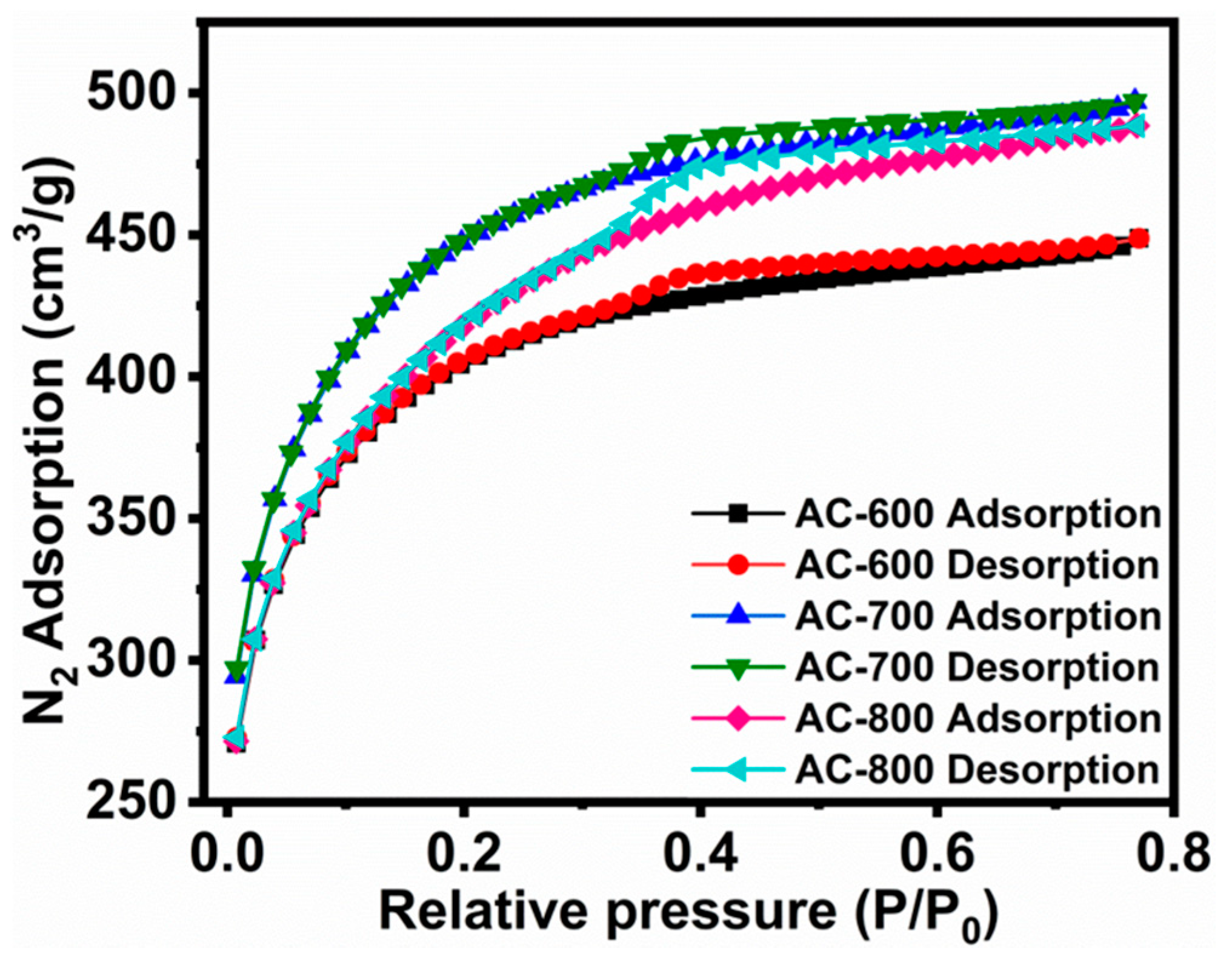


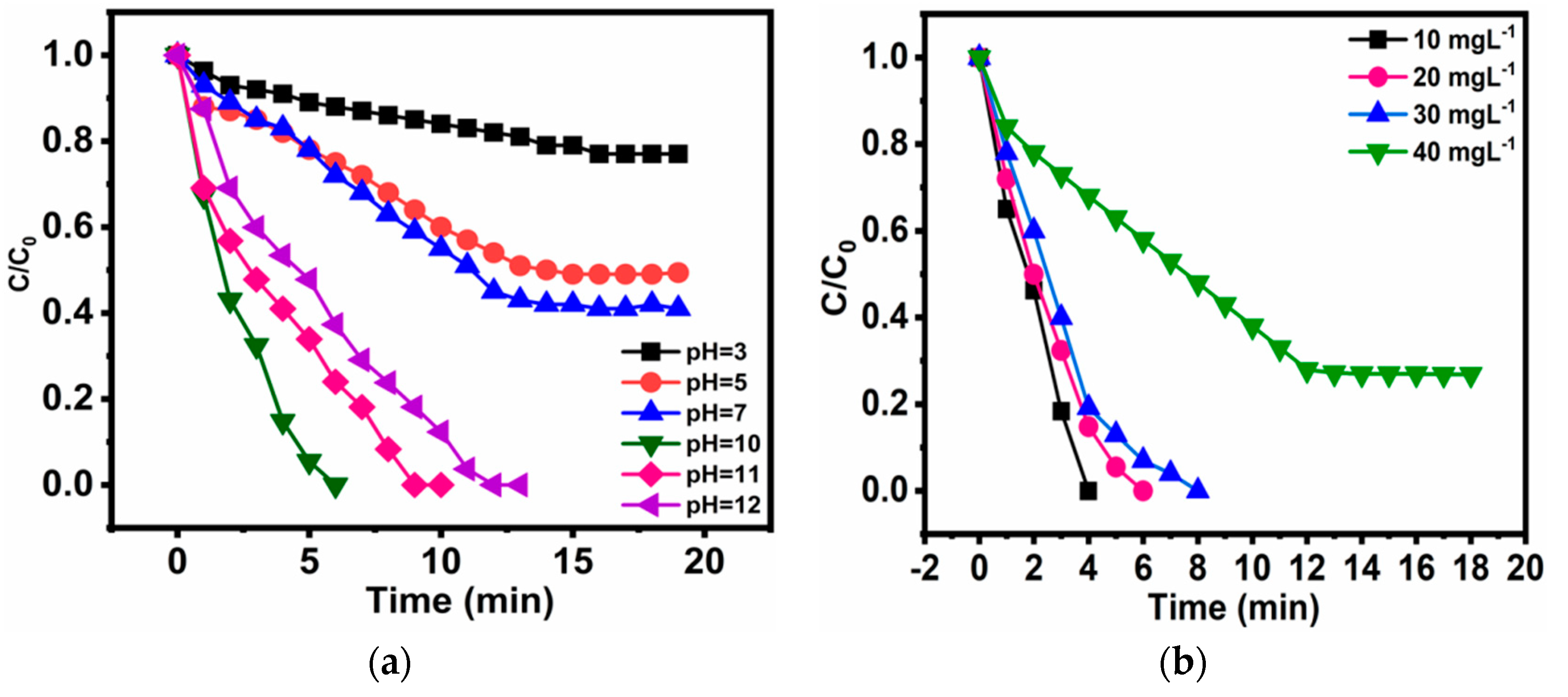
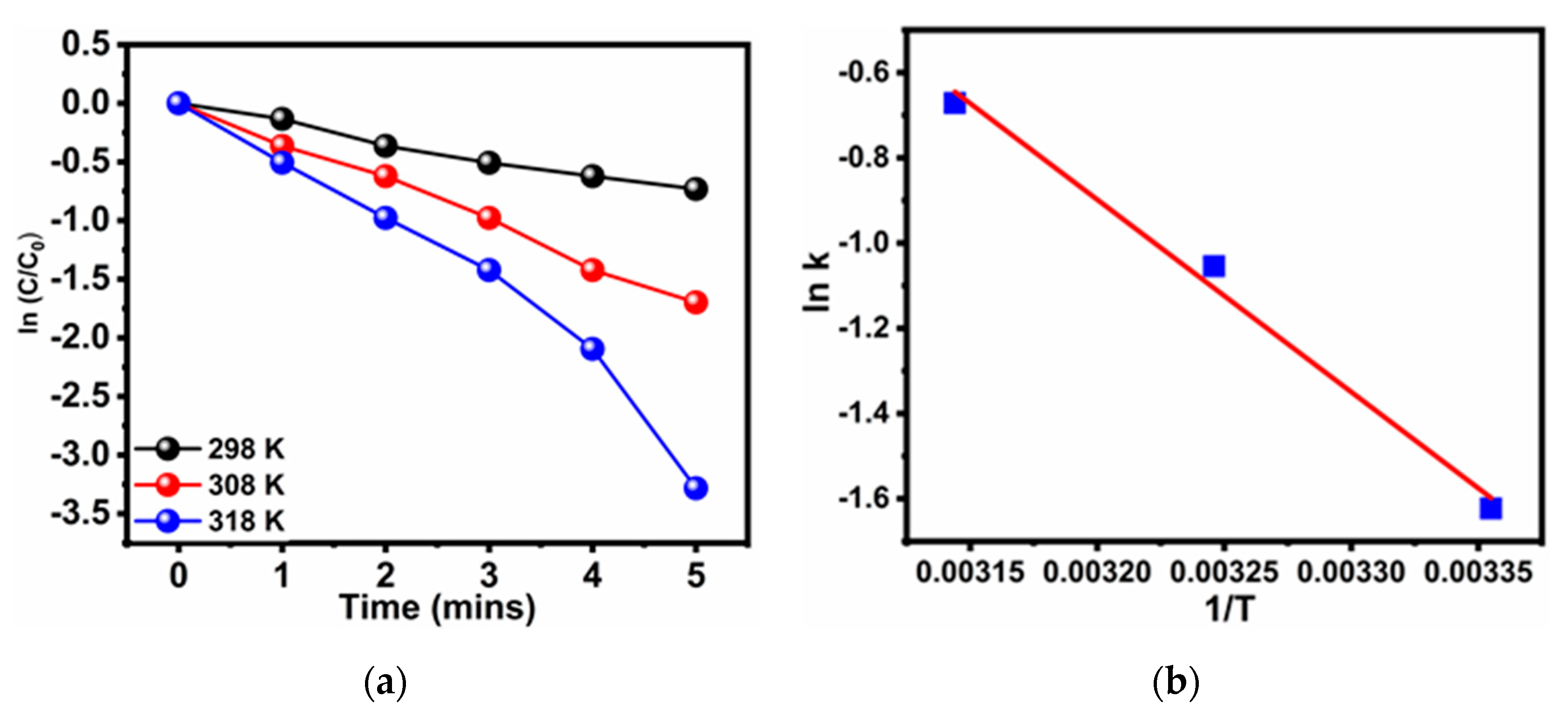
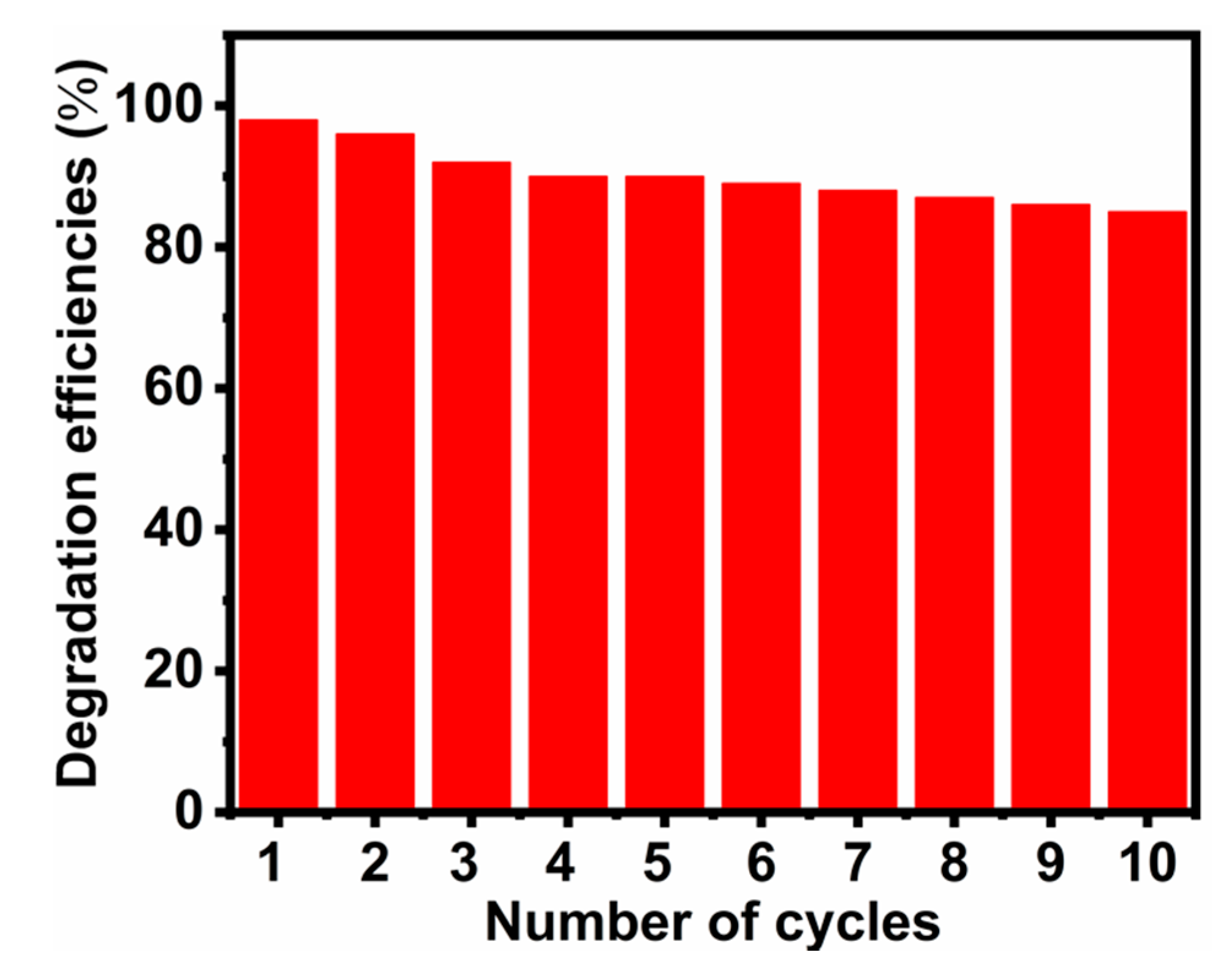
| Sample | BET Surface Area (m2/g) | Pore Size (nm) | BJH Adsorption Pore Volume (cm3/g) |
|---|---|---|---|
| AC-600 | 1365.5 | 2.03 | 0.233 |
| AC-700 | 1509.7 | 2.14 | 0.332 |
| AC-800 | 1405.8 | 2.07 | 0.274 |
© 2020 by the authors. Licensee MDPI, Basel, Switzerland. This article is an open access article distributed under the terms and conditions of the Creative Commons Attribution (CC BY) license (http://creativecommons.org/licenses/by/4.0/).
Share and Cite
Hira, S.A.; Yusuf, M.; Annas, D.; Hui, H.S.; Park, K.H. Biomass-Derived Activated Carbon as a Catalyst for the Effective Degradation of Rhodamine B dye. Processes 2020, 8, 926. https://doi.org/10.3390/pr8080926
Hira SA, Yusuf M, Annas D, Hui HS, Park KH. Biomass-Derived Activated Carbon as a Catalyst for the Effective Degradation of Rhodamine B dye. Processes. 2020; 8(8):926. https://doi.org/10.3390/pr8080926
Chicago/Turabian StyleHira, Shamim Ahmed, Mohammad Yusuf, Dicky Annas, Hu Shi Hui, and Kang Hyun Park. 2020. "Biomass-Derived Activated Carbon as a Catalyst for the Effective Degradation of Rhodamine B dye" Processes 8, no. 8: 926. https://doi.org/10.3390/pr8080926
APA StyleHira, S. A., Yusuf, M., Annas, D., Hui, H. S., & Park, K. H. (2020). Biomass-Derived Activated Carbon as a Catalyst for the Effective Degradation of Rhodamine B dye. Processes, 8(8), 926. https://doi.org/10.3390/pr8080926





